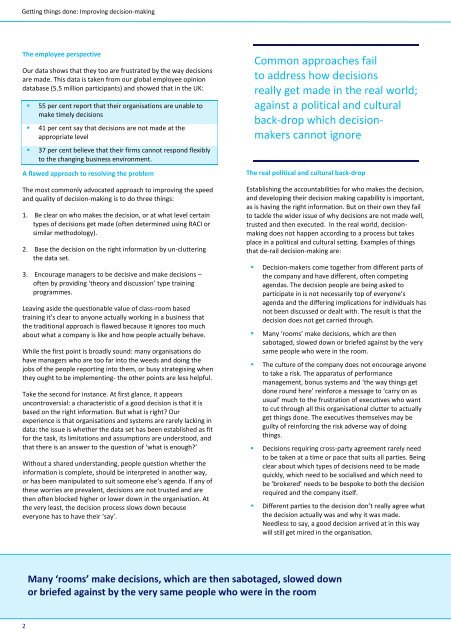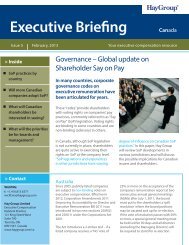Gettting things done: Improving decision-making - Hay Group
Gettting things done: Improving decision-making - Hay Group
Gettting things done: Improving decision-making - Hay Group
Create successful ePaper yourself
Turn your PDF publications into a flip-book with our unique Google optimized e-Paper software.
Getting <strong>things</strong> <strong>done</strong>: <strong>Improving</strong> <strong>decision</strong>-<strong>making</strong><br />
The employee perspective<br />
Our data shows that they too are frustrated by the way <strong>decision</strong>s<br />
are made. This data is taken from our global employee opinion<br />
database (5.5 million participants) and showed that in the UK:<br />
• 55 per cent report that their organisations are unable to<br />
make timely <strong>decision</strong>s<br />
• 41 per cent say that <strong>decision</strong>s are not made at the<br />
appropriate level<br />
• 37 per cent believe that their firms cannot respond flexibly<br />
to the changing business environment.<br />
A flawed approach to resolving the problem<br />
The most commonly advocated approach to improving the speed<br />
and quality of <strong>decision</strong>-<strong>making</strong> is to do three <strong>things</strong>:<br />
1. Be clear on who makes the <strong>decision</strong>, or at what level certain<br />
types of <strong>decision</strong>s get made (often determined using RACI or<br />
similar methodology).<br />
2. Base the <strong>decision</strong> on the right information by un-cluttering<br />
the data set.<br />
3. Encourage managers to be decisive and make <strong>decision</strong>s –<br />
often by providing ‘theory and discussion’ type training<br />
programmes.<br />
Leaving aside the questionable value of class-room based<br />
training it’s clear to anyone actually working in a business that<br />
the traditional approach is flawed because it ignores too much<br />
about what a company is like and how people actually behave.<br />
While the first point is broadly sound: many organisations do<br />
have managers who are too far into the weeds and doing the<br />
jobs of the people reporting into them, or busy strategising when<br />
they ought to be implementing- the other points are less helpful.<br />
Take the second for instance. At first glance, it appears<br />
uncontroversial: a characteristic of a good <strong>decision</strong> is that it is<br />
based on the right information. But what is right? Our<br />
experience is that organisations and systems are rarely lacking in<br />
data: the issue is whether the data set has been established as fit<br />
for the task, its limitations and assumptions are understood, and<br />
that there is an answer to the question of ‘what is enough?’<br />
Without a shared understanding, people question whether the<br />
information is complete, should be interpreted in another way,<br />
or has been manipulated to suit someone else’s agenda. If any of<br />
these worries are prevalent, <strong>decision</strong>s are not trusted and are<br />
then often blocked higher or lower down in the organisation. At<br />
the very least, the <strong>decision</strong> process slows down because<br />
everyone has to have their ‘say’.<br />
Common approaches fail<br />
to address how <strong>decision</strong>s<br />
really get made in the real world;<br />
against a political and cultural<br />
back-drop which <strong>decision</strong>makers<br />
cannot ignore<br />
The real political and cultural back-drop<br />
Establishing the accountabilities for who makes the <strong>decision</strong>,<br />
and developing their <strong>decision</strong> <strong>making</strong> capability is important,<br />
as is having the right information. But on their own they fail<br />
to tackle the wider issue of why <strong>decision</strong>s are not made well,<br />
trusted and then executed. In the real world, <strong>decision</strong><strong>making</strong><br />
does not happen according to a process but takes<br />
place in a political and cultural setting. Examples of <strong>things</strong><br />
that de-rail <strong>decision</strong>-<strong>making</strong> are:<br />
• Decision-makers come together from different parts of<br />
the company and have different, often competing<br />
agendas. The <strong>decision</strong> people are being asked to<br />
participate in is not necessarily top of everyone’s<br />
agenda and the differing implications for individuals has<br />
not been discussed or dealt with. The result is that the<br />
<strong>decision</strong> does not get carried through.<br />
• Many ‘rooms’ make <strong>decision</strong>s, which are then<br />
sabotaged, slowed down or briefed against by the very<br />
same people who were in the room.<br />
• The culture of the company does not encourage anyone<br />
to take a risk. The apparatus of performance<br />
management, bonus systems and ‘the way <strong>things</strong> get<br />
<strong>done</strong> round here’ reinforce a message to ‘carry on as<br />
usual’ much to the frustration of executives who want<br />
to cut through all this organisational clutter to actually<br />
get <strong>things</strong> <strong>done</strong>. The executives themselves may be<br />
guilty of reinforcing the risk adverse way of doing<br />
<strong>things</strong>.<br />
• Decisions requiring cross-party agreement rarely need<br />
to be taken at a time or pace that suits all parties. Being<br />
clear about which types of <strong>decision</strong>s need to be made<br />
quickly, which need to be socialised and which need to<br />
be ‘brokered’ needs to be bespoke to both the <strong>decision</strong><br />
required and the company itself.<br />
• Different parties to the <strong>decision</strong> don’t really agree what<br />
the <strong>decision</strong> actually was and why it was made.<br />
Needless to say, a good <strong>decision</strong> arrived at in this way<br />
will still get mired in the organisation.<br />
Many ‘rooms’ make <strong>decision</strong>s, which are then sabotaged, slowed down<br />
or briefed against by the very same people who were in the room<br />
2
















